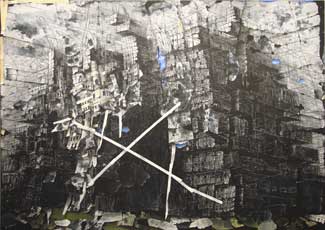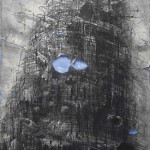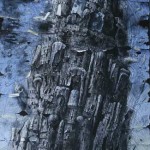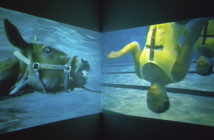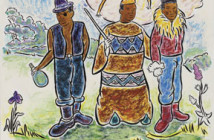Among the many paradoxes that pervade Gerry Bergstein's life and art (and these interpenetrate in myriad ways), perhaps the most central is that of his status in the world of art. He is at once a classic painter, reaching toward the to be hoped-for fecundity of old age, and an exceptionally contemporary artist, immersed in the flotsam and jetsam of today's popular culture. He deploys his immense painterly skill and bravura - techniques ranging from trompe l'oeil to paint scratching and impasto - in the service of a jumbled up imagery, non-sequiturs seemingly more at home in the worlds of comics and electronic multimedia. He is both a respectable Newbury Street painter (with links to Boston Expressionism), and one of the most iconoclastic (and iconophiliac) artists in town. One could say that he is a postmodern artist in old master drag.
His latest show, his first at Gallery NAGA, finds him working through these contradictions with wildly uneven results. Bergstein advances the apocalyptic architectural imagery of his recent work, but also experiments with photography and sculpture, as well as reviving some painterly motifs from the past. The result, while containing more than its fair share of breathtaking work, is not as strong as I had hoped.
The exhibition space is dominated by several epic (and often epically scaled) architectural fabulations, done on canvas and paper. Cities, domes, spheres, towers and walls rise up in front of skies of gray or blue (sometimes tinted with yellow and pink). These are drawn by scratching into the paint surface, resulting in a wild tangle of lines that somehow coalesce into recognizable forms. The effect has been compared to the freedom of Piransei's Carceri etchings; it also bears a relationship to the organic yet structural forms of Terry Winters, another painterly draftman.
Somewhere in the foreground of each of these (the surprisingy utopian Location, Location, Location excepted) is a small figure sculpted out of an often absurdly thick impasto. He always wears the same white t-shirt and blue jeans, an Everyman lost in a strange world. The figure is Gerry himself, but he also acts as a stand-in for the viewer, a way of penetrating these forbiddingly dense vistas. In some pictures, he holds up a map or canvas, contemplating the scene before him. In others, he takes a more active role, interacting with the material of the cities themselves. In both cases, he is an explorer, trying to find a sense of place in world composed of dislocations and nested (ir)realities.
As if all of this is not enough, the backgrounds of these cityscapes seem to be paper patchwork constructions. Tearing and fraying into bits and pieces, these "backgrounds" are full of holes revealing other layers beneath, layers that we come to suspect are just as unreal as those masking them. Bits of (painted) masking tape appear to be one of the few things preventing total collapse. In What Should I Paint and Barricade, the tape pieces become major compositional elements in themselves. In the latter painting, they form an "X", blocking (or perhaps holding up) a cavernous opening in an otherwise solid looking fortification.
Do You Come Here Often is the tallest work in the show, measuring a whopping 108 by 52 inches, and reaching nearly to the ceiling of the gallery. The central bullet shaped tower occupies most of this space. More than any of the other paintings in the show, it is a portrait, a building head covered with bulbous protrusions. It is the least conventionally architectural of Bergstein's building paintings included in the show. A likely influence here is Archimboldo's faces composed of fruit.
Brueghel's famous Tower of Babel has been another important reference point in Gerry recent work. One small oil on paper piece - entitled appropriately enough, Babel - is a relatively literal re-imagining of the classic painting. Here the hapless and ill-fated tower is engulfed in a deluge of clouds and waves, reminiscent of Leonardo and Pollock alike. The Gerry figure leans back with his arms raised, holding a blank rectangle which might be a canvas or (perhaps in keeping with the Biblical themes), a slate. The compact, mostly monochromatic scene compilments the larger, more complex works nicely.
Two small paper paintings, Roadmap (2004) and Sitting in the Stars (2006), form a sort of before and after sequence (they are hung near each other). Both are of roughly similar size and feature Gerry standing on a ground of tangled short brushstrokes--green, with hints of pink, ochre, and light gray. In front of these foregrounds are paper curtains, depicting the usual ever changing sci-fi architecture. In the earlier painting, he holds up a sheet of paper. Presumably he is consulting a map, although the resemblance to the seen in front of him is vague if not wholly imaginary. The curtain is gray-blue, punctured by a whole in the middle, and trailing off at the top to reveal a black starry sky. In the later painting, the curtain has turned a stronger blue and is now on the verge of collapse. The ground has turned red and yellow in spots, suggesting fire. Fortunately, Bergstein has sprung into action, painting a curtain fragment with his left arm raised (he holds a palette in his other hand). The tension between the contemplative observation of the first piece and the action (painting) of the second appears elsewhere in the show, and in his larger body of work as well.
As a dedicated painter in an art world which often favors individuals working in a bewildering array of media, it is hardly surprising that Bergstein attempts to stretch out here. The results are mostly unsatisfactory, serving mainly to remind one of what a great painter he is. Most daring is Gerry's Brain, a conglomeration of paper cutout images kept from scattering by copious amounts of Scotch tape. The imagery is mostly familiar, but includes a few surprises: legs wearing jeans and boots, snapshots of the artist and some of his familiars, rulers. More problematic than its crudeness is its overly literal character, a disappointment coming from an artist in whose work what you see is rarely what you see. This is the sort of thing he has been painting all along; to see it it forcibly removed from the picture plane and dumped out on the floor lacks the kind of visceral thrill that one might expect.
Much of the same goes for a series of four digital prints, two of them with hand painted additions. With the exception of Artwalk II, each depicts a variation of Brain (and that one is a close relation). The repetition tries to make a case for the motif's domination of the show, but I wasn't convinced. The most sucessful of the lot is Gurney, which shows an improbably flat image cluster on a hospital gurney familiar to anybody who has visited Bergstein's South End studio. While the combination of painting and photography may be of conceptual interest, the digital printouts look distressingly thin when compared to the artist's lush brushwork.
Three of Bergstein's paintings feel unduly retrospective, harking back to the artist's concerns of about half a decade ago. (For what its worth, 1999 marked my own first exposure to his work.) One of these, The Agony and the Ecstasy, is actually a work from 2002, hence essentially forgivable, if out of place here. Framed in an illusionistic chalkboard - an elongated relative of the one found in Magritte's The Two Mysteries - are two self-portrait busts, painted so as to resemble pencil drawings. One's mouth is gaping (ecstasy?), while the other displays a rather stoic variety of agony. Impasto sculpture pencils point to anatomical details, while an equally thick paintbrush on the right side of the image releases a white paint spatter that in some areas transmutes into a rip in the blackboard, revealing blue skies beyond.
Tail and Homage, both painted last year, make epic physical adventures out of cultural hero worship. Both feature colored "paper cutout" shapes set against a blue starry background. Individual cutouts name some of Bergstein's myriad painterly ancestors, with a few contemporaries thrown as well: Matisse, Guston, Ivan Albright, Brueghel, De Kooning, Magritte, Vija Celmins, Gail Boyajian (his wife). In Tail, these form a heart shape, from which emerge two threads: one a cord keeping these fragments from floating off into the ether, the other supporting Gerry himself. The artist dangles from a similar rope in Homage, only this time it is supported only by a piece of illusionistic masking tape affixed to the heavens. Trailing him is a paper envelope toy house. The cutouts here are childlike cosmic signs: stars, planets and an ice cream cone shaped comet. Again, these two paintings, for all their ingenuity and skill, feel like throwbacks.
One feels bad dismissing such high-quality work; nevertheless, their place in the show is suspect. This is a modest gallery show, not a large museum retrospective. Hence, one would like to see a tighter focus and an emphasis on moving forward rather than looking back. As for the photo works, they feel more like diversions than progressions. Bergstein's work is already immensely eclectic and multifaceted without these forced distractions.
Links:
Gallery Naga
"Gerry Bergstein: This is Your Brain on Art" is on view October 13 - November 4, 2006 at Gallery NAGA.
All images are courtesy of the artist and Gallery NAGA.

